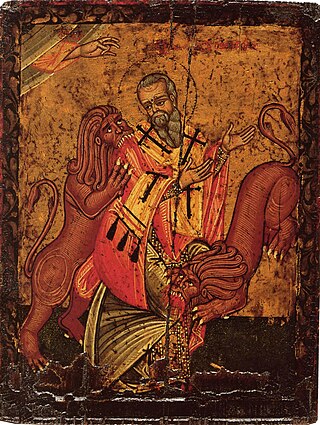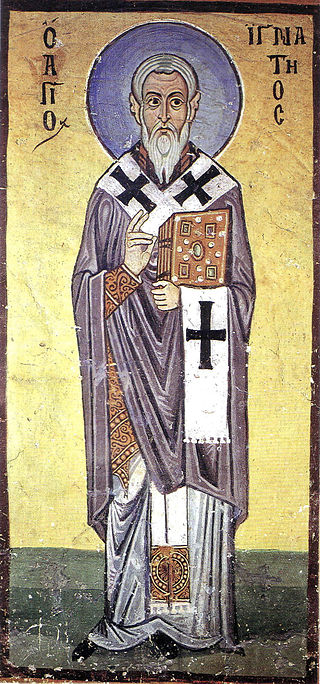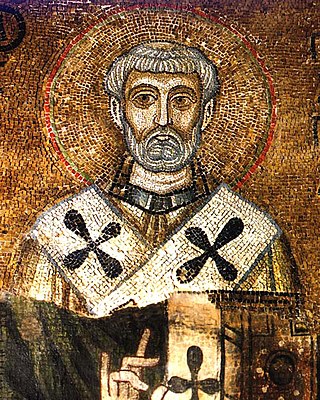Related Research Articles

The word catholic comes from the Greek phrase καθόλου 'on the whole, according to the whole, in general', and is a combination of the Greek words κατά 'about' and ὅλος 'whole'. The first known use of "Catholic" was by the church father Saint Ignatius of Antioch in his Letter to the Smyrnaeans. In the context of Christian ecclesiology, it has a rich history and several usages.

Ignatius of Antioch, also known as Ignatius Theophorus, was an early Christian writer and Patriarch of Antioch. While en route to Rome, where he met his martyrdom, Ignatius wrote a series of letters. This correspondence forms a central part of a later collection of works by the Apostolic Fathers. He is considered one of the three most important of these, together with Clement of Rome and Polycarp. His letters also serve as an example of early Christian theology, and address important topics including ecclesiology, the sacraments, and the role of bishops.

Polycarp was a Christian bishop of Smyrna. According to the Martyrdom of Polycarp, he died a martyr, bound and burned at the stake, then stabbed when the fire failed to consume his body. Polycarp is regarded as a saint and Church Father in the Catholic Church, Eastern Orthodox Church, Oriental Orthodox Churches, Lutheranism, and Anglicanism.

Clement of Rome, also known as Pope Clement I, was the bishop of Rome in the late first century AD. He is listed by Irenaeus and Tertullian as the bishop of Rome, holding office from 88 AD to his death in 99 AD. He is considered to be the first Apostolic Father of the Church, one of the three chief ones together with Polycarp and Ignatius of Antioch.
The Apostolic Fathers, also known as the Ante-Nicene Fathers, were core Christian theologians among the Church Fathers who lived in the 1st and 2nd centuries AD who are believed to have personally known some of the Twelve Apostles or to have been significantly influenced by them. Their writings, though widely circulated in early Christianity, were not included in the canon of the New Testament. Many of the writings derive from the same time period and geographical location as other works of early Christian literature which came to be part of the New Testament.
Vicar of Christ is a term used in different ways and with different theological connotations throughout history. The original notion of a vicar is as an "earthly representative of Christ", but it's also used in the sense of "person acting as parish priest in place of a real person." The title is now used in Catholicism to refer to the bishops, and more specifically, was historically used to refer to the Bishop of Rome.

The First Epistle to Timothy is one of three letters in the New Testament of the Bible often grouped together as the pastoral epistles, along with Second Timothy and Titus. The letter, traditionally attributed to the Apostle Paul, consists mainly of counsels to his younger colleague and delegate Timothy regarding his ministry in Ephesus (1:3). These counsels include instructions on the organization of the Church and the responsibilities resting on certain groups of leaders therein as well as exhortations to faithfulness in maintaining the truth amid surrounding errors.

The Epistle of Polycarp to the Philippians is an epistle attributed to Polycarp, an early bishop of Smyrna, and addressed to the early Christian church in Philippi. It is widely believed to be a composite of material written at two different times, in the first half of the second century. The epistle is described by Irenaeus as follows:

The Epistle of Ignatius to the Trallians is an epistle attributed to Ignatius, a second-century Bishop of Antioch and martyr, and addressed to the church in Tralles. It was written during the bishop's transport from Antioch to his execution in Rome.

The Epistle of Ignatius to the Smyrnaeans is an epistle from circa 110 A.D. attributed to Ignatius of Antioch, a second-century bishop of Antioch, addressed to the Early Christians in Smyrna.

Debate exists as to whether the earliest Church Fathers in Christian history believed in the doctrine of the Trinity – the Christian doctrine that God the Father, the Son and the Holy Spirit are three distinct persons sharing one homoousion (essence).

Saint Peter, also known as Peter the Apostle, Simon Peter, Simeon, Simon, or Cephas, was one of the Twelve Apostles of Jesus Christ and one of the first leaders of the early Christian Church. He appears repeatedly and prominently in all four New Testament gospels as well as the Acts of the Apostles. Catholic tradition accredits Peter as the first bishop of Rome—or pope—and also as the first bishop of Antioch.

John Gambold, was bishop of the Unitas Fratrum.

The Church Fathers, Early Church Fathers, Christian Fathers, or Fathers of the Church were ancient and influential Christian theologians and writers who established the intellectual and doctrinal foundations of Christianity. The historical period in which they worked became known as the Patristic Era and spans approximately from the late 1st to mid-8th centuries, flourishing in particular during the 4th and 5th centuries, when Christianity was in the process of establishing itself as the state church of the Roman Empire.
The Eastern Orthodox Church is opposed to the Roman Catholic doctrine of papal supremacy. While not denying that primacy does exist for the Bishop of Rome, Eastern Orthodox Christians argue that the tradition of Rome's primacy in the early Church was not equivalent to the current doctrine of supremacy.

The Epistle of Ignatius to the Romans is an epistle attributed to Ignatius of Antioch, a second-century bishop of Antioch. It was written during his transport from Antioch to his execution in Rome. To the Romans contains Ignatius’ most detailed explanation of his views on martyrdom.

The Epistle of Ignatius to the Magnesians is an epistle attributed to Ignatius of Antioch, a second-century bishop of Antioch, and addressed to the church in Magnesia on the Maeander. It was written during Ignatius' transport from Antioch to his execution in Rome.

The Epistle of Ignatius to Polycarp is an epistle attributed to Ignatius of Antioch, a second-century bishop of Antioch, and addressed to Polycarp, the bishop of Smyrna. It was written during Ignatius' transport from Antioch to his execution in Rome.

The Epistle of Ignatius to the Philadelphians is an epistle attributed to Ignatius of Antioch, a second-century bishop of Antioch, and addressed to the church in Philadelphia of Asia Minor. It was written during Ignatius' transport from Antioch to his execution in Rome.

The Epistle of Ignatius to the Ephesians is an epistle attributed to Ignatius of Antioch, a second-century bishop of Antioch, and addressed to the church in Ephesus of Asia Minor. It was written during Ignatius' transport from Antioch to his execution in Rome.
References
- ↑ Ignatius to the Magnesians 2:1.
- ↑ John GAMBOLD, Thomas ERSKINE (of Linlathen.), The works of J. G. With an introductory essay, by T. Erskine, etc (Chalmers & Collins, 1823) p81.
- ↑ The Epistle of Ignatius to the Magnesians.
- ↑ Ignatius to the Magnesians .
- ↑ John Gambold, The Martyrdom of Ignatius: A Tragedy (I. Ashmead & Company for J. Wright, 1832)p21.
- ↑ Ignatius to the Magnesians 3:1.
- ↑ [Church History (Book 3:36:5.
- ↑ Church History Book 3:36:5.